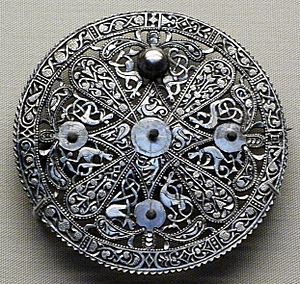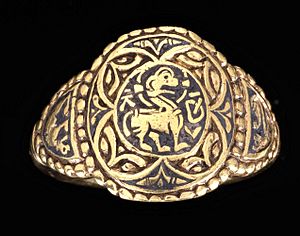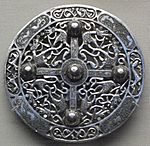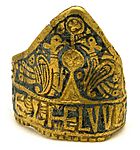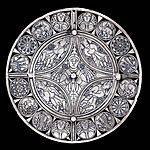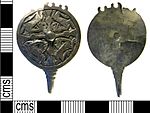Trewhiddle style facts for kids
The Trewhiddle style is a special kind of art from the Anglo-Saxon times. It gets its name from a treasure called the Trewhiddle Hoard. This treasure was found in Trewhiddle, Cornwall, way back in 1770.
Trewhiddle art uses silver and a dark metal inlay called niello. It features cool designs of animals, plants, and shapes. These designs are often woven together and carved in tiny sections. Some famous examples of this style include the Pentney Hoard, the Abingdon sword, the Fuller brooch, and the Strickland brooch.
Contents
Discovering the Trewhiddle Style
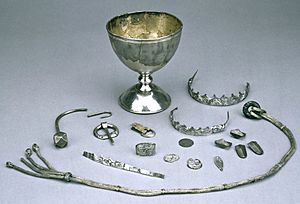
The Trewhiddle style is named after the Trewhiddle Hoard. This treasure was found in 1774 near Trewhiddle, Cornwall. The hoard included Anglo-Saxon coins, a silver cup, and other gold and silver items. These items are from the 800s.
The animal designs on some of the Trewhiddle Hoard items became very important. Experts in Anglo-Saxon art and history studied them a lot. Sir Thomas Kendrick was the first historian to show how Anglo-Saxon animal art was used continuously. It went from the end of Roman Britain into the early Anglo-Saxon period.
A Danish archaeologist named Johannes Brøndsted saw how important these lively designs were. He named this art style from the 800s the "Trewhiddle style."
The Trewhiddle style likely grew out of older Anglo-Saxon art. The Animal style and complex patterns found in early England kept developing. One expert, David M. Wilson, said that animal art from 450 to 950 AD shows the same traditions. He noted that animals on items like the Faversham brooch and Sutton Hoo clasps led to the Trewhiddle style.
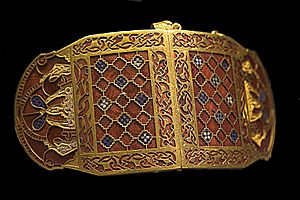
Art experts have noticed that Trewhiddle art is similar to Irish art. However, no one thinks Irish art directly influenced Trewhiddle art. It's more likely that the animal art in Trewhiddle objects started in England. It was only slightly influenced by art from places like the Mediterranean, Francia, or the Celtic world.
Older scholars thought the Trewhiddle style only existed in the 800s. It has been hard to date because there isn't much other evidence to help. As more Trewhiddle items are found, some now think the style might have started in the 700s.
New discoveries, like those in Yorkshire in the 1980s and 1990s, suggest the style continued. It might have been made in Northern England into the 900s. But for now, most experts still date the style to the 800s.
What Makes Trewhiddle Style Special?
The Trewhiddle style is known for its detailed carvings. These carvings include animals, plants, interwoven patterns, and geometric shapes. It also uses niello inlays and often has surfaces covered in designs. Another key feature is that the main decorated area is split into small sections. These sections are usually separated by beaded lines.
Each small section often has just one design. This is usually a crouching, backward-looking, or biting animal. Artists often used speckles on individual designs. This helped create texture or show movement.
There are many animal shapes, including mythical birds, snakes, and beasts. They are usually shown from the side. Plant designs range from single carved leaves to whole plants. These are often mixed with animal shapes and interwoven patterns.
Interwoven patterns are more often seen with animal and plant designs. When used alone, the interwoven pattern is usually simple and closed. When used with plants or animals, the design is generally more complex.
Metalwork Creations
Trewhiddle style was mostly used to decorate metal items. During the later Anglo-Saxon period, silver was the most common precious metal used. It was used for Trewhiddle style jewelry and to decorate weapons.
Viking trade and expansion in the 800s and 900s brought new silver supplies to England and Scandinavia. Because there was so much new silver, craftsmen quickly started using it instead of gold. Gold then became the preferred metal for finger-rings or for adding gold details.
Weapons with Trewhiddle Art
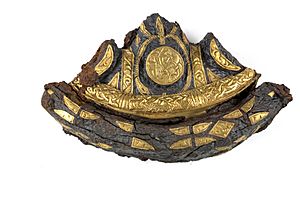
Trewhiddle was a popular style for decorating late Anglo-Saxon swords. The Abingdon sword, found near Abingdon, has silver parts with niello inlay. The River Witham sword has a silver handle decorated with Trewhiddle style animal designs and niello.
The sword pommel from the Bedale Hoard has panels with gold foil inlay. It's decorated with carved, intertwined animals and a fancy gold leaf pattern. This Anglo-Saxon weapon is from the late 800s or early 900s.
Three sword handles from Norway (Høven, Dolven, and Gronneberg) were made in the Trewhiddle style. All of them have niello inlays. The Dolven and Gronnenberg handles look similar to the River Witham sword. The Høven handle has intertwined bird and animal shapes, like the Fuller Brooch.
Jewelry with Trewhiddle Art
Anglo-Saxon jewelry from the 800s and early 900s is known for its amazing craftsmanship. It has lively, detailed carved designs. Silver disc brooches with open-work designs in the Trewhiddle style are the most famous examples of this jewelry.
The Pentney Hoard is probably the best-known example of Trewhiddle style. This Anglo-Saxon treasure was found in a churchyard in Pentney, Norfolk, in 1978. It includes six silver open-work disc brooches from the early 800s. There are two pairs of brooches that don't quite match, and two single brooches.
The Æthelwulf and Æthelswith finger-rings are important gold items in the Trewhiddle style. These rings belonged to Æthelwulf, King of Wessex and his daughter, Æthelswith (who lived from 838 to 888 AD). Æthelwulf was the father of Alfred the Great. He ruled from 836 to 858 AD. Æthelswith was Queen of Mercia from 853 to 874.
These rings are special because they show unusual Christian pictures. Æthelswith's ring has the Lamb of God. Æthelwulf's ring shows two peacocks drinking at the Fountain of Life.
The Fuller Brooch is a silver brooch with niello inlay and detailed carvings. It's from the late 800s. This round brooch shows the Five Senses. It's a late Trewhiddle style piece, with Trewhiddle animals, birds, plants, and even humans. It's rare because it uses human-like shapes. It is considered one of the most famous examples of Anglo-Saxon art.
The Strickland Brooch is a silver disc brooch with niello inlay from the mid-800s. It looks similar to the Fuller Brooch. Both pieces are made from thin silver and have niello and gold inlay. The Strickland Brooch has a lively open-work design. It's carved with detailed dog-like beasts with collars and animal heads.
Strap-ends with Trewhiddle Art
Late Anglo-Saxon strap-ends were often decorated in the Trewhiddle style. Strap-ends are accessories that go on the end of a strap or belt to stop it from unraveling. The eight strap-ends from the Poppleton hoard are great examples. They were found near Upper Poppleton, Yorkshire, and date from the late 800s to early 900s.
Images for kids
- Trewhiddle examples
-
Abingdon Sword pommel
See also
- Insular art
- Migration period art
- Celtic art
- Viking art


